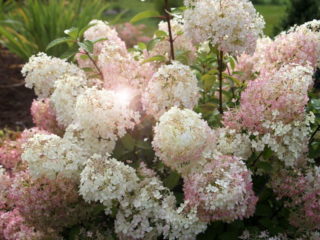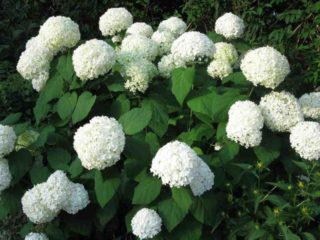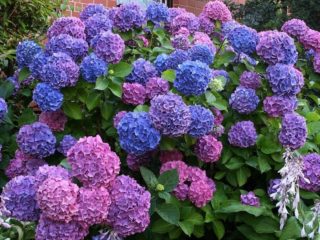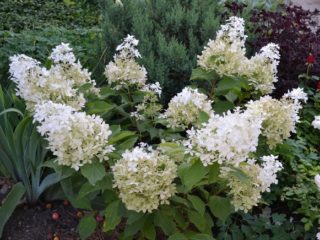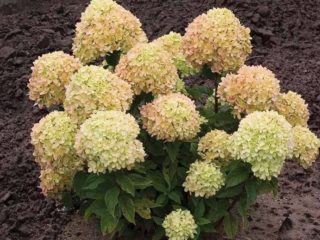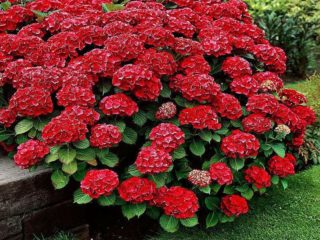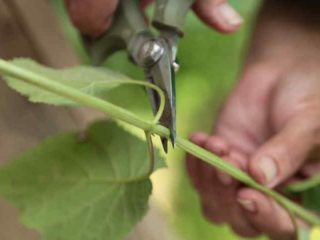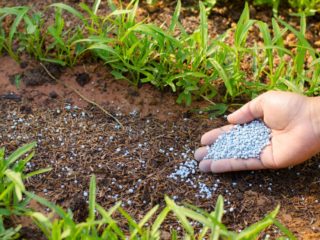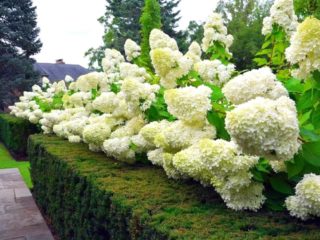Content
The amazingly delicate Angel Blanche hydrangea can transform even the most modest garden plot. The main feature of the shrub, whose contours resemble a fountain of flowers, is the gradual change of shades by its inflorescences: from white to pink, and then to red.
Description of hydrangea Angel Blanche
"Angels Blush" translated from English means "blush of angels." And indeed, the soft pink inflorescences in their appearance resemble the blushing cheeks of an innocent girl.
The full name of the crop is panicle hydrangea (Hydrangea paniculata) Angels Blush. With proper care, a multi-stemmed shrub can reach 3 m in height and increase in volume up to 2 meters, while maintaining the correct rectangular shape.
The shoots of the culture are upright with a reddish tint to the bark. They are distinguished by fast growth and medium thickness. The leaf blades, pointed at the ends, have the shape of an ellipse 10-12 cm long. The color of the leaves is bright green.
The inflorescences are cone-shaped, collected in fluffy panicles up to 23-25 cm long. The flowering period begins in July with a white-cream hue, which gradually changes to pink and by the last month of flowering (October) to dark red.
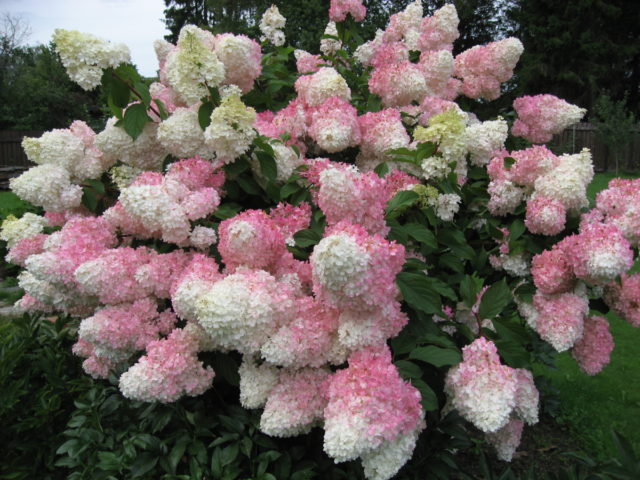
Flowering lasts from late July to November
Hydrangea paniculata Angel Blanche in landscape design
Hydrangea looks organic both in single and group plantings. Separate landscape compositions are often created with it. The culture's flexibility in shaping and pruning allows the designer to play with the size of the bush and its shape.
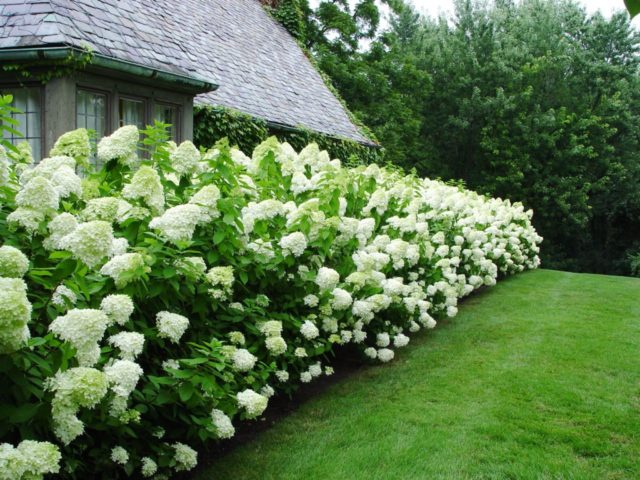
Inflorescences are great for cutting
An upright plant is often used as a flowering hedge to divide the garden into zones. When planted alone, Angel Blanche hydrangea is planted on lawns, depending on the lighting preferences of this species.
Designers use paniculate hydrangea to create gardens in Russian and English styles. In the first case, planting occurs next to trees, in the second - inside a landscape composition with the same color during the flowering period.
Almost all types of hydrangea are sensitive to the composition of the soil. In slightly alkaline soil, the inflorescences acquire pink tones; in soil with high acidity, blue tones.
Hydrangea Angel Blanche is often placed in the center of the composition, with herbaceous crops planted along the edges. Also, this shrub is often placed at the entrance to the garden or plot.
Its ease of care and interesting appearance make the shrub popular with landscape designers who combine Angel Blanche with conifers, boxwood, bergenia, and juniper.
Conifers acidify the soil, so planting next to them is very useful for any type of hydrangea. The combination of dark green conifers and soft pink inflorescences looks very harmonious.
Bergenia blooms earlier than hydrangea (from April to May), but in summer its leaves acquire a reddish tint, which fits perfectly with the pink-red inflorescences of hydrangea.
The combination of Angel Blanche and juniper is popular. Both plants are often used to create original hedges. The moisture-loving nature of the crop allows it to be planted near artificial or natural reservoirs.
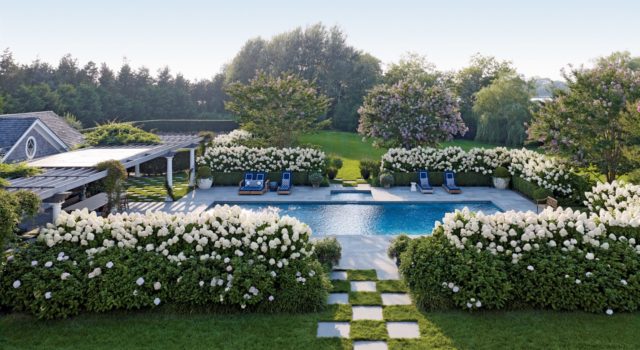
Flowering begins with white, then pink flowers, and by autumn they become dark red
Hydrangea is often used to create a natural landscape garden style. This is possible due to the culture’s ability to tolerate shade well. Angel Blanche, planted in random order, makes the design of the site less monotonous and boring.
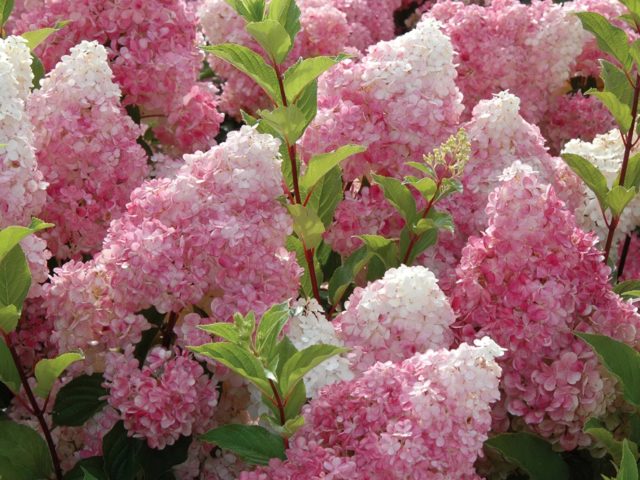
The color of the inflorescences depends on the acidity of the soil
Winter hardiness of Hydrangea paniculata Angels Blush
Hydrangea of this species is characterized by high winter hardiness, so it can be safely planted even in the middle zone. The culture can withstand low temperatures down to – 25-30 °C.
In harsh winters, young plants require shelter. Otherwise, the shoots may freeze.
Planting and caring for Hydrangea paniculata Angel Blanche
Hydrangea Angel Blanche can decorate any corner of the garden with its appearance. However, before planting, it is necessary to take into account the requirements of the shrub, both to the planting site and to the composition of the soil.
Selection and preparation of a landing site
The area for paniculate hydrangea should be well lit. Although the shrub blooms best in partial shade.Therefore, a place close to a fence or next to trees is ideal for planting. As for direct sunlight, it will not harm the plant, but can still affect the brightness of the chameleon color of the inflorescences.
The lush color of Angel Blanche hydrangea will be provided by fertile red soil loam. But on sandy soil and calcareous soil the plant weakens. The shrub shows the most beautiful shade of inflorescences on acidic soils, so if necessary, add pine compost, sawdust or brown peat to the soil.
Landing rules
The planting time determines the year of flowering of the Angel Blanche hydrangea. In the southern regions, planting of the crop is carried out already in March. In this case, the shrub pleases with lush flowering in mid-summer. In the northern regions, plants are planted in April. By this time, the soil has warmed up enough and the hydrangea takes root well and has time to take root.
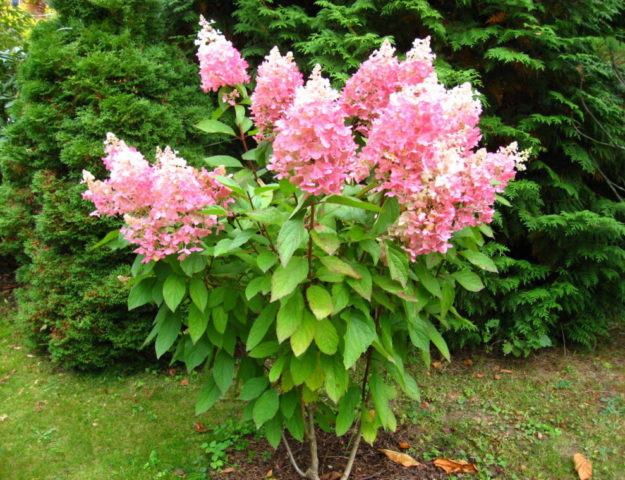
The best time for planting is early spring and autumn (September)
Hydrangea is transplanted to a permanent place at the age of at least 4-5 years. Since by this time the root system of the shrub is growing significantly, the location is chosen based on its parameters.
Step-by-step landing algorithm:
- Make a planting hole with a diameter of 50 cm, or 80×80 if the root system is well developed.
- Pour at least 3 buckets of water into the hole and leave for 6-8 hours so that the water is absorbed and the soil is moistened to the maximum.
- Make a substrate from peat, compost, fertile soil and sand in a ratio of 2:1:2:1.
- Add fertilizer to the mixture in the form of superphosphate (65 g), potassium sulfate (25 g) and urea (25 g).
- Immediately before planting, it is necessary to trim the roots and shoots of one year of life, leaving no more than 5 pairs of buds on each.
- Plant the shrub in the hole, carefully straightening the roots and cover everything with substrate.
- Mulch the soil around the plant's trunk.
Watering and fertilizing
A plant of this species requires intensive watering and soil moisture. Under normal climatic conditions, the shrub is watered once every 6-7 days. The amount of water required is 22-25 liters per bush. During particularly dry periods, the volume is increased to 30 liters. Moistened soil should be at least 1.5 meters around the crop.
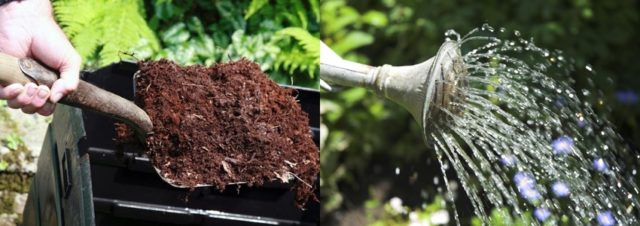
The plant loves moist soil and frequent watering.
Since Angel Blanche is a fast-growing species, it requires appropriate feeding. In the spring, green fertilizers rich in nitrogen are used, which affect the growth rate and future foliage of the bush. Also at this time, the plant is actively watered with mullein infusion and nettle decoction. Mineral fertilizers are applied 2 times a month during the formation of inflorescences. In the fall, mineral complexes are added to help the crop survive the winter.
Trimming
Shrub pruning has several functions:
- Stimulates growth.
- Eliminates weak and diseased shoots.
- Corrects the external contours of the bush, shapes the crown.
Stimulating pruning is carried out in the spring before flowering. If everything is done correctly, then it has a beneficial effect on the duration of the flowering period and the number of inflorescences.
Sanitary pruning is carried out in the fall at the end of flowering and immediately after winter. Its main goal is to remove diseased and frozen branches and improve the health of the plant.
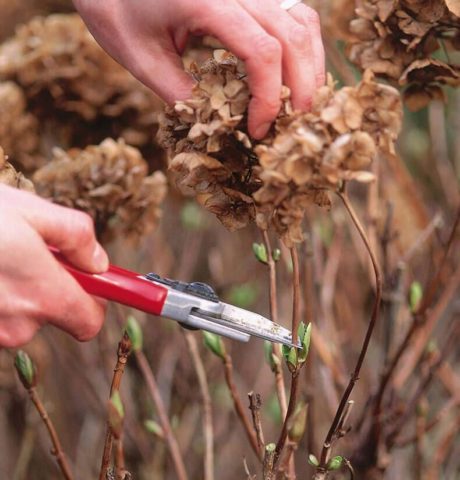
Pruning stimulates the growth of hydrangea and subsequently forms an even crown
Preparing for winter
Despite the winter hardiness in the middle zone and in the northern regions, preparatory work is carried out with Angel Blanche hydrangea before the start of the cold period.
Immediately after pruning, the soil in the tree trunk circle is cleared of leaves, branches and insects that have left for the winter. Water-charging irrigation is carried out, after which the soil is mulched. Compost, peat, sawdust, spruce or rotted manure are used as mulch. The thickness of the mulch layer should not be less than 20 cm.
Reproduction
Hydrangea Angel Blanche propagates in 2 ways: layering and cuttings. The blanks for the latter are the shoots remaining after pruning.
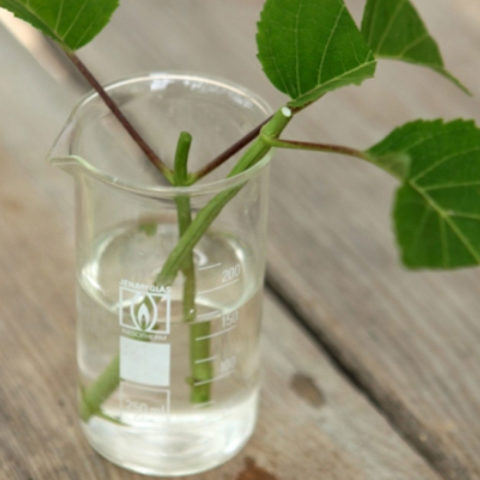
Hydrangea is propagated by cuttings, dividing the bush, seeds or grafting
Cuttings are cut in the first ten days of the summer month, when the shoots contain a large amount of moisture and are easier to tolerate outside interference. Each cutting 10 cm long should have from 3 to 5 buds. Planting material is soaked in a growth stimulator for at least 2 days.
It is more difficult to propagate hydrangea by layering. Young side shoots are bent from the main bush, pressed to the ground (without breaking) and the ends of the shoots are tied to special pegs. Some of the “grounded” branches are sprinkled with a substrate of compost and fertile soil. Over time, the cuttings develop their own root system and can be replanted.
Diseases and pests
Hydrangea Angel Blanche has good immunity to diseases and pests.The most common problem on shrubs of this species is powdery mildew. The best way to combat it is Bordeaux mixture, prepared from copper sulfate and slaked lime.

Bordeaux mixture is used against powdery mildew.
As for pests, hydrangea is most often attacked by aphids. You can cope with this problem with a folk remedy - tincture of garlic (250 g of chopped cloves per 10 liters of water, mixed with 50 g of grated laundry soap).
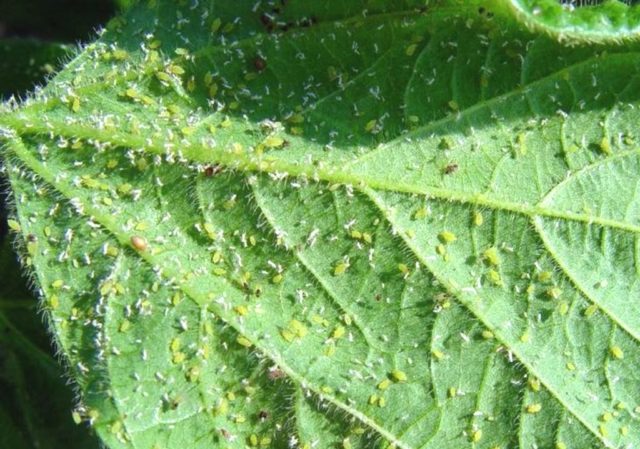
Garlic tincture works great against aphids on hydrangeas
Conclusion
Hydrangea Angel Blanche is an amazingly beautiful shrub that is often used to create landscape design compositions. Planting and caring for the crop is simple, but we must not forget about a number of nuances that accompany the agricultural technology of this plant.
Reviews of hydrangea Angel Blanche
You can find many reviews about hydrangea on the Internet. Users share their characteristics of their favorite species, as well as how to care for them.
